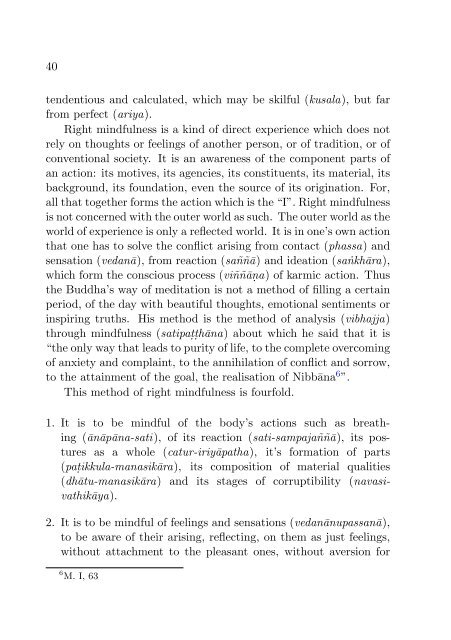Truth and the Way
The Noble Truths and the Way to realise them.
The Noble Truths and the Way to realise them.
You also want an ePaper? Increase the reach of your titles
YUMPU automatically turns print PDFs into web optimized ePapers that Google loves.
40<br />
tendentious <strong>and</strong> calculated, which may be skilful (kusala), but far<br />
from perfect (ariya).<br />
Right mindfulness is a kind of direct experience which does not<br />
rely on thoughts or feelings of ano<strong>the</strong>r person, or of tradition, or of<br />
conventional society. It is an awareness of <strong>the</strong> component parts of<br />
an action: its motives, its agencies, its constituents, its material, its<br />
background, its foundation, even <strong>the</strong> source of its origination. For,<br />
all that toge<strong>the</strong>r forms <strong>the</strong> action which is <strong>the</strong> “I”. Right mindfulness<br />
is not concerned with <strong>the</strong> outer world as such. The outer world as <strong>the</strong><br />
world of experience is only a reflected world. It is in one’s own action<br />
that one has to solve <strong>the</strong> conflict arising from contact (phassa) <strong>and</strong><br />
sensation (vedanā), from reaction (saññā) <strong>and</strong> ideation (saṅkhāra),<br />
which form <strong>the</strong> conscious process (viññāṇa) of karmic action. Thus<br />
<strong>the</strong> Buddha’s way of meditation is not a method of filling a certain<br />
period, of <strong>the</strong> day with beautiful thoughts, emotional sentiments or<br />
inspiring truths. His method is <strong>the</strong> method of analysis (vibhajja)<br />
through mindfulness (satipaṭṭhāna) about which he said that it is<br />
“<strong>the</strong> only way that leads to purity of life, to <strong>the</strong> complete overcoming<br />
of anxiety <strong>and</strong> complaint, to <strong>the</strong> annihilation of conflict <strong>and</strong> sorrow,<br />
to <strong>the</strong> attainment of <strong>the</strong> goal, <strong>the</strong> realisation of Nibbāna 6 ”.<br />
This method of right mindfulness is fourfold.<br />
1. It is to be mindful of <strong>the</strong> body’s actions such as breathing<br />
(ānāpāna-sati), of its reaction (sati-sampajaññā), its postures<br />
as a whole (catur-iriyāpatha), it’s formation of parts<br />
(paṭikkula-manasikāra), its composition of material qualities<br />
(dhātu-manasikāra) <strong>and</strong> its stages of corruptibility (navasivathikāya).<br />
2. It is to be mindful of feelings <strong>and</strong> sensations (vedanānupassanā),<br />
to be aware of <strong>the</strong>ir arising, reflecting, on <strong>the</strong>m as just feelings,<br />
without attachment to <strong>the</strong> pleasant ones, without aversion for<br />
6 M. I, 63
















